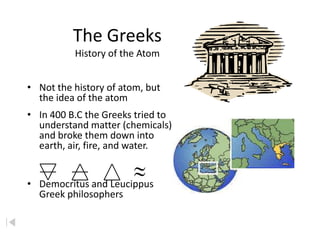
Atomic history day #1
- 1. The Greeks History of the Atom • Not the history of atom, but the idea of the atom • In 400 B.C the Greeks tried to understand matter (chemicals) and broke them down into earth, air, fire, and water. • Democritus and Leucippus Greek philosophers
- 2. Greek Model “To understand the very large, we must understand the very small.” Democritus • Greek philosopher • Idea of ‘democracy’ • Idea of ‘atomos’ – Atomos = ‘indivisible’ – ‘Atom’ is derived • No experiments to support idea Democritus’s model of atom • Continuous vs. discontinuous No protons, electrons, or neutrons theory of matter Solid and INDESTRUCTABLE
- 3. Alchemy • After that chemistry was ruled by alchemy. • They believed that that could take any cheap metals and turn them into gold. • Alchemists were almost like magicians. – elixirs, physical immortality
- 4. Contributions of alchemists: Information about elements - the elements mercury, sulfur, and antimony were discovered - properties of some elements Develop lab apparatus / procedures / experimental techniques - alchemists learned how to prepare acids. - developed several alloys - new glassware
- 5. Early Ideas on Elements Robert Boyle stated... – A substance was an element unless it could be broken down to two or more simpler substances. – Air therefore could not be an element because it could be broken down in to many pure substances. Robert Boyle
- 6. Dalton Model of the Atom Late 1700’s - John Dalton- England Teacher- summarized results of his experiments and those of other’s Combined ideas of elements with that of atoms in Dalton’s Atomic Theory
- 7. Foundations of Atomic Theory Law of Conservation of Mass Mass is neither destroyed nor created during ordinary chemical reactions. Law of Definite Proportions The fact that a chemical compound contains the same elements in exactly the same proportions by mass regardless of the size of the sample or source of the compound. Law of Multiple Proportions If two or more different compounds are composed of the same two elements, then the ratio of the masses of the second element combined with a certain mass of the first elements is always a ratio of small whole numbers.
- 8. Daltons Atomic Theory • Dalton stated that elements consisted of tiny particles called atoms • He also called the elements pure substances because all atoms of an element were identical and that in particular they had the same mass.
- 9. Dalton’s Theory Continued • He also said the reason why elements differed from one another was that atoms of each element had different masses. • He also said that compounds consisted of atoms of different elements combined together. • Dalton's model was that the atoms were tiny, indivisible, indestructible particles and that each one had a certain mass, size, and chemical behavior that was determined by what kind of element they were.
- 10. Thomson Model of the Atom J. J. Thomson - English physicist. 1897 Made a piece of equipment called a cathode ray tube. It is a vacuum tube - all the air has been pumped out.
- 11. A Cathode Ray Tube Source of Electrical Potential Stream of negative particles (electrons) Metal Plate Gas-filled glass tube Metal plate Zumdahl, Zumdahl, DeCoste, World of Chemistry 2002, page 58
- 12. Plum-Pudding Model Zumdahl, Zumdahl, DeCoste, World of Chemistry 2002, page 56